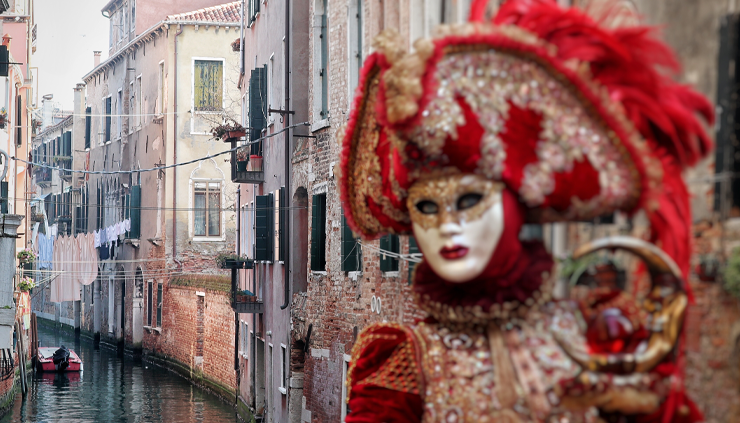What is Carnevale?
Carnival is one of the most entertaining festivities around the world and the Carnevale in Italy is no exception. It is the celebration of chaos, mockery of authorities and exaggerated social satire, and we all know that Italians are very good at it.
When is Carnevale celebrated in Italy?
Although the origins of Carnival trace back to pagan festivities of Greeks and Romans, it is linked to the Catholic world.
In fact, it is celebrated on Shrove Tuesday, the last day when it is allowed to feast before the rigors of Lent. Consequently, it doesn’t have a specific date but depends on which day Easter will be.
Etymology of the word Carnevale
The name Carnival (Carnevale in Italian) comes from Latin carnem levare, which literally means remove the meat. Specifically, Carnival was the last occasion for meat consumption, as people abstained from it during the following forty days of Lent.
How is Carnevale celebrated in Italy?
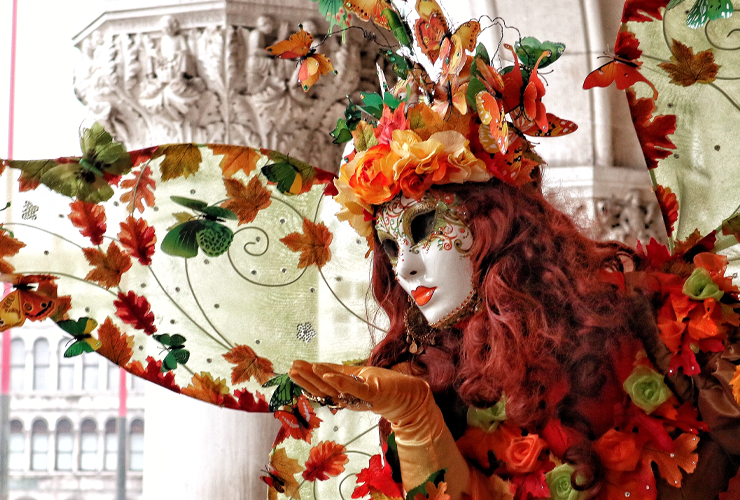
The Carnevale in Italy represents a way through which people can set aside their everyday life and simply have fun.
Usually, folk of all ages wear elaborate costumes and masks, throwing at each other confetti and streamers. Additionally, they take part in joyful parades, street parties and other entertainments.
Moreover, in almost every Italian city there is an important Carnival tradition: the creation of huge floats. In fact, it is a serious matter for Italians, as they compete for the best carro (float in English) every year. The price? The glory, but that’s enough.
But how does it work? Easy! First, groups of people gather to choose a theme for their float, usually at night after school or work. Then, they start creating the machines.
Specifically, some work with papier-mache, while others help design clothes. Eventually, they show their creations during the parades, which become an actual competition for the best carro.
Similarly, primary schools too organize colorful parades based on different themes. For instance, they dress up kids as animals, protagonists of fairy tales or cartoons.
Traditional food of Carnevale in Italy
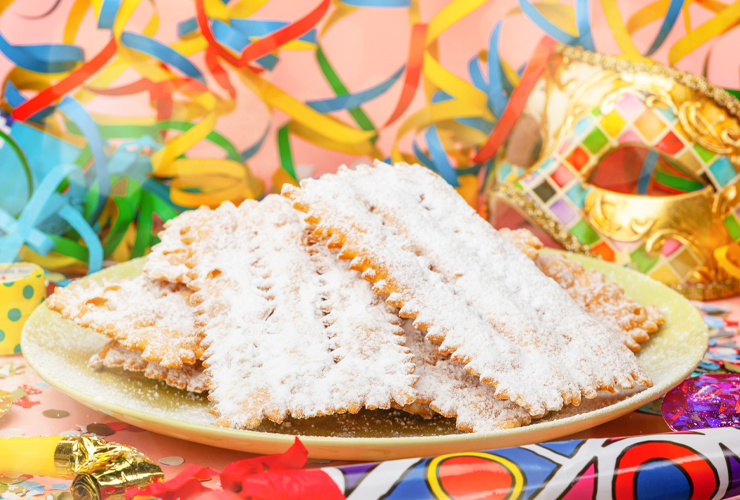
Needless to say, food plays an important role in the Italian Carnevale.
Truly, the queen of the Carnival menu is undoubtedly the lasagna.
Nonetheless, on the table you will find any kind of delicious meat dishes and countless bottles of wine. Of course, do not forget to save some space for dessert.
Specifically, every region and city have a traditional dessert to serve at the end of the Carnival lunch.
Among the most common carnival desserts, the so-called Chiacchiere deserve first place (Angel wings for the English speakers). Basically, they are sweet crisp pastries shaped into thin twisted ribbons, deep-fried and sprinkled with powdered sugar.
Similarly, the Castagnole (Castagnola for the singular) are a typical sweet of the Carnevale in Italy. The shape of this fried little ball recalls chestnuts, consequently its name comes from castagna, the Italian word for chestnut.
In addition, a traditional Carnival dessert of the Campania region is the so-called Migliaccio. This cake has the same ingredients of the Sfogliatelle’s filling: semolina, ricotta cheese, candied fruits, eggs, sugar and vanilla. A real treat!
However, there are plenty of Italian Carnival dishes, but it would be impossible to write about every of them here. Nonetheless, if you are fond of Italian culinary traditions, go check our latest article on the Italian desserts.
And now, let’s continue the discovery of the Italian Carnival celebrations!
Traditional Carnival masks in Italy
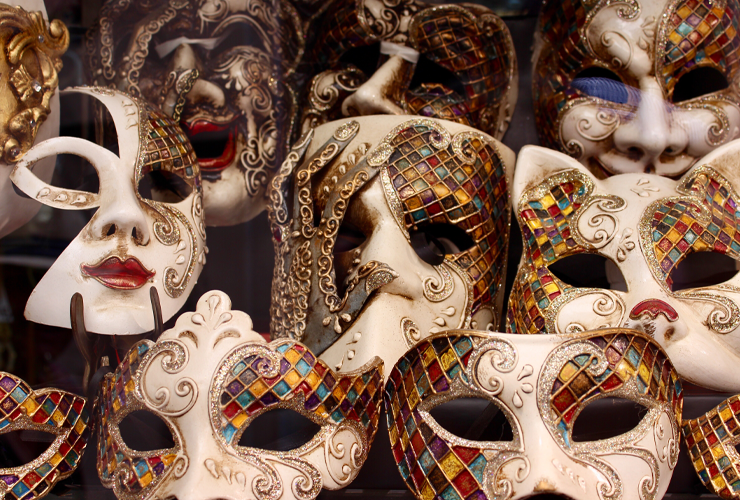
Together with the floats, another symbol of the Carnevale in Italy are the masks. In fact, throughout the years every Italian region has created its own characteristic mask.
They come from puppetry, Italian folklore and from an early form of professional theatre called Commedia dell’arte (meaning Comedy of profession).
As we said before, their aim was to mock authorities and social rules. As a matter of fact, they are a mix of fierce satire and funny parody. So, why don’t we have a look at some of them?
From the North…
Of course, one of the best-known way to celebrate Carnevale in Italy is with the Mask of Arlecchino (Harlequin in English) and his chequered colorful costume. He is an astute servant and with his agility and trickster qualities always tries to thwart his master’s plans.
Then, in the city of Milan we find another famous mask: Meneghino. This witty but honest servant is one of the few characters of the Commedia dell’arte, who doesn’t wear a mask.
Instead, in Venice we meet a completely different character: Pantalone. He is a greedy merchant with an exceptional ego. Therefore, over the years he has become the metaphorical representation of money.
Likewise, the Emilian mask Balanzone (known as the Doctor among English speakers) is a parody of the educated elite. He is a pompous inept, fond of drinks, chocolate and girls. Also, he always pretends to be an expert in subjects that he actually doesn’t know.
Another popular Italian mask is the Turinese Gianduja. When hearing this name, the first that comes to your mind is chocolate, I know. But even if the two things are related, we are talking about a totally different thing. In fact, Gianduja is an honest peasant of the Piedmontese country land, with an inclination for wine and beautiful girls.
…To the South!
Then, when we talk about Carnevale in Italy, how could we forget about the Neapolitan Pulcinella? He is an ignorant but astute servant, who is always on the side of the winner. With the white costume, black mask and huge nose has gradually become one of the symbols of Italian culture worldwide.
And finally, another iconic Neapolitan mask: Tartaglia. Usually, he is depicted as a clumsy lower working class’ member, short-sighted and with a minor stutter.
Of course, all these masks are not just awkward movements and hilarious tricks. Indeed, there is far more in them then we could imagine. They are the results of history events, revolutions and oppressions. They rise from stereotypes and represent some regional features and traditions.
Now, speaking of regional traditions, we just have to explore the most famed examples of Carnevale in Italy.
Venetian Carnival
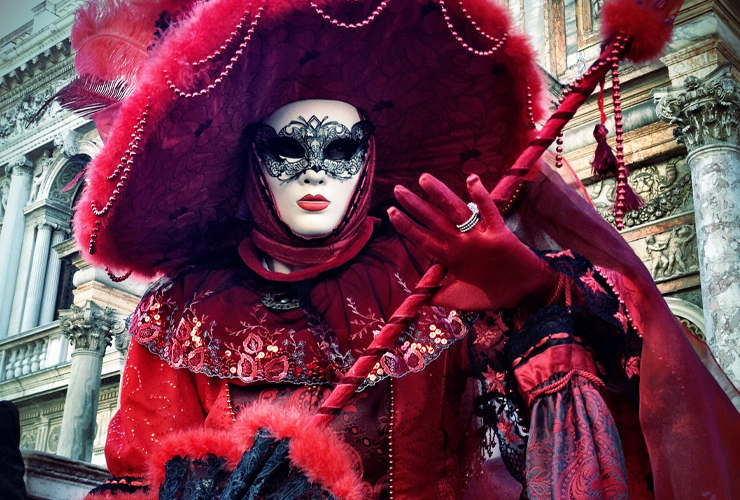
Of course, the first that comes to mind is the Carnival of Venice. It attracts a great number of tourists from all over the world. According to legend, its celebration began after an important military victory of the Venetian Republic in 1162. Then, it became official in the Renaissance.
However, in spite of its fame the Emperor Francis II outlawed the Venetian Carnival in the late XVIII century. And only later, in 1979, it officially returned.
Nowadays, the Carnevale in Venice is a long celebration and has three major events in it.
First, the so-called Festa delle Marie, in which twelve girls walk down the streets and receive prizes. This event celebrates the kidnapping and the release of twelve brides-to-be in the late XI century.
Second, the Volo di Sant’Angelo (literally “Saint Angel’s fly”), when an acrobat gets down from the bell tower of San Marco Church to reach the square.
And third, the Svolo del Leon (Venetian dialectal form for “The Lion’s fly”), which concludes the Carnival with a tribute to the Winged Lion, symbol of Venice.
Moreover, masks are an important feature of the Venetian Carnival. Originally, they were simple in design, decoration, and with a symbolic and practical function. Of course, many things have changed.
For instance, the materials. In fact, while once mask makers used leather, porcelain or glass, nowadays they prefer gypsum and gold leaf. Eventually, they hand-paint the masks and decorate them with natural feathers and gems. Literally outstanding piece of art!
The Carnival of Viareggio
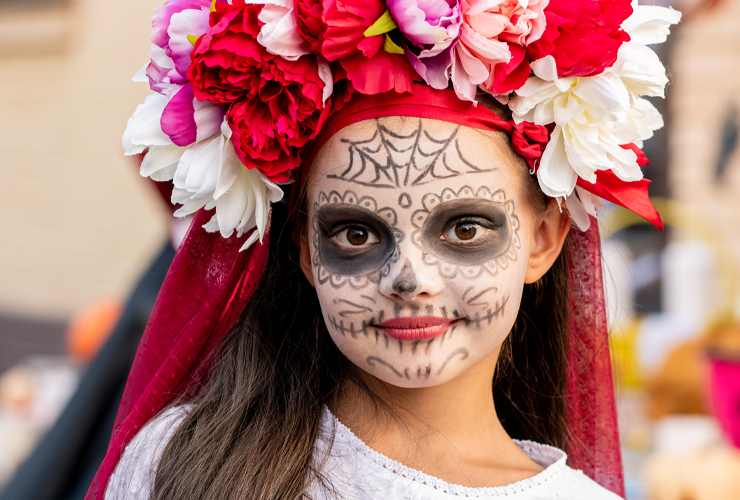
Anotehr important Carnevale in Italy is the Carnival of Viareggio (Carnevale di Viareggio in Italian): a month-long Tuscan Carnival and one of Europe’s longest-established festivals.
Some wealthy middle-class men organized the first Viareggio carnival parade in 1873. However, on that occasion several citizens decided to put on masks as a sign of protest against the high taxes. Therefore, today people still use masks to remember that distant event.
However, what makes the Carnevale di Viareggio unique are its papier-mâché allegorical gigantic floats. Indeed, the largest one tower 70 feet over the crowds and weigh about 40 tons.
Due to their dimension, the floats are built in an apposite seat, called Cittadella del Carnevale (Carnival Citadel in English). In addition, Carnival celebrations are scheduled every weekend night in the city’s different quarters, which host all-night masked parties.
Later, on Carnival day the parade of floats and masks colors the streets of the city. Also, it includes competitions of traditional music bands for the most original masks.
The Carnival of Cento
Cento Carnival is one of the most ancient Carnevale in Italy and it is also twinned with the Carnival of Rio de Janeiro.
Similarly, to the Viareggio Carnival, the one in Cento is a month-long celebration. Here, the local Carnival societies compete for the most original float and show their creations in the parades.
Additionally, during the displays people from the floats throw at the crowd a great number of inflatables and plushes.
Then, on the last Sunday a jury awards the winning society and gives a prize also for the throwing of toys and gadgets. Finally, at the end of the last parade a firework show accompanies the burning of the traditional mask Tasi. This event concludes this incredible Carnival.
The Ivrea Carnival
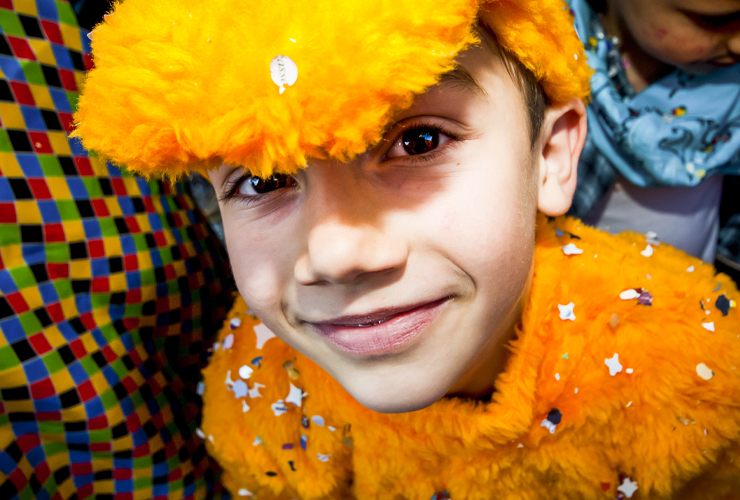
This Carnival is world-known especially for the Battle of the Oranges and it is one of the best Carnevale in Italy!
According to the legend, in the XII century the tyran of the city tried to rape the young Violetta on the evening of her wedding. However, the girl fought back and decapitated him, generating a revolution.
Every year the citizens remember their liberation with the Battle of the Oranges, where the fruits represent the old weapons and stones. Indeed, teams of aranceri (orange handlers) on foot throw oranges against the aranceri riding in carts (representing the tyrant’s ranks).
Finally, the Carnival ends on Shrove Tuesday with a silent march, the solemn funeral of the tyran.
Acireale Carnival
This is the most beautiful Sicilian Carnival, but also one of the most ancient Carnevale in Italy. Likewise, the others, it has parades with huge papier-mache floats and both traditional and modern masks.
Furthermore, on the last week of celebrations another kind of floats parades along the streets. We are talking about the so-called Carri Infiorati (from fiore, flower in English).
These big floats are fully covered with lights and thousands of flowers, whose scent makes this Carnival a unique experience.
The Carnival of Fano
One of the sweetest Carnevale in Italy is undoubtedly the one in the city of Fano, in the Marche region. Among the most ancient, it takes place on the three Sundays before Lent.
Again, the protagonists are the huge allegorical papier-mache floats, which mock politicians, actors and other VIP.
They parade three times along the streets. During the first lap, participants show their float. Then in the second one, they throw chocolate and candies at the crowd. Finally, on the third lap, they turn the lights on, creating a memorable picturesque image for the audience.
Carnival vocabulary and expressions
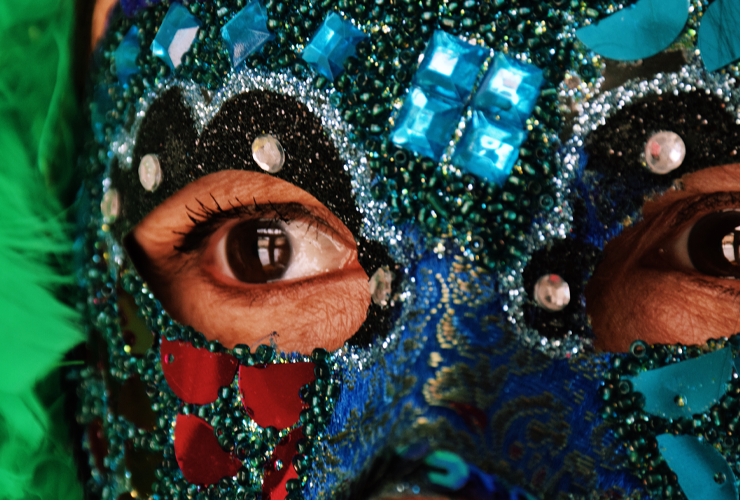
In case I made you curious and you’re planning to test the Carnevale in Italy, I leave a list of useful words below!
| Carnevale | Carnival |
| maschera | mask |
| costume | costume |
| carro | float |
| sfilata | parade |
| coriandoli | confetti |
| stelle filanti | streamers |
| Martedì Grasso | Shrove or Fat Tuesday (the day in which Carnival falls) |
| Mercoledì delle Ceneri | Ash Wednesday (the day after Fat Tuesday) |
| Quaresima | Lent |
Also, I would like to share with you some of the most used Italian Carnival expressions.
| Italian motto | English translation | Meaning |
| A Carnevale ogni scherzo vale. | Anything goes at Carnival time. | On Carnival day you can do any prank you want. |
| A Carnevale il povero va a zappare | At Carnival the poor man hoes. | Once poor people couldn’t allow themself to celebrate Carnival instead of working. |
| Carnevale al sole, Pasqua al fuoco. | Carnival under the sun, Easter on fire. | Carnival fun leads to Easter contrition. |
| Carnevale guarisce ogni male | Carnival heals every harm. | The fun on Carnival makes you happy. |
| Chi si marita male non fa mai carnevale | Who gets married badly doesn’t celebrate Carnival. | Who chooses a bad husband/wife could never be happy. |
Now, you are ready to talk with Italians about Carnival and not only about the weather!
Conclusion
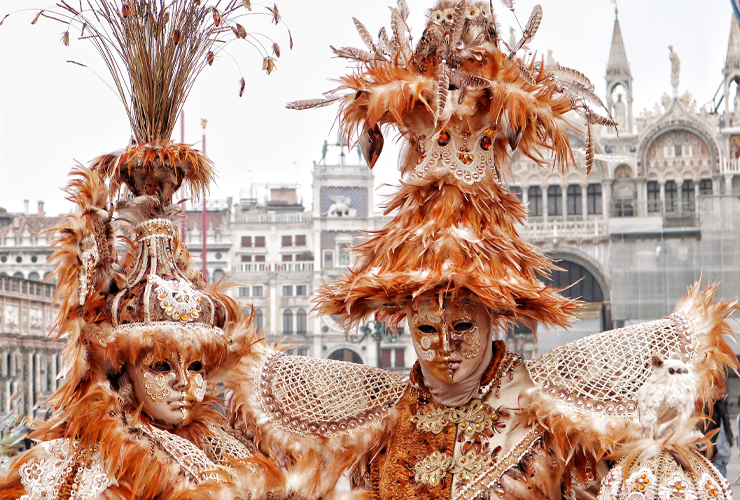
Whether it is in the North or in the South, the Carnevale in Italy fills the streets with laughter, colors and joy.
If you love Italian culture and want an immersive experience in it, then Carnival celebration is what you need.
So, what are you waiting for? Check when the next Carnival is and book a flight to Italy.
An extraordinary fun experience is waiting for you!

